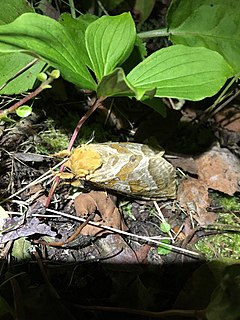Schausiana is a monotypic moth genus of the family Hepialidae described by Pierre Viette in 1950. The only described species is Schausiana trojesa, described by William Schaus in 1901, which is endemic to Mexico.

Abantiades latipennis, known as the Pindi moth, is a species of moth in the family Hepialidae. It may also be referred to as a swift moth or a ghost moth, as this is a common name associated with Hepialidae. Endemic to Australia and identified in 1932, it is most populous in temperate rainforest where eucalypti are prevalent, as the larvae feed primarily on the roots of these trees. Females lay eggs during flight in a scattering fashion. The larvae live for over eighteen months underground, while adult moths survive for approximately one week, as they have no mouthparts with which to feed. The moths are preyed upon by a number of predators, including bats and owls. Brown in colour overall, males are paler and the identifying silver bars of the male's wings are more prominent than those of the female's, with dark margins. Male adults are generally smaller.
William Schaus was an American entomologist who became known for his major contribution to the knowledge and description of new species of the Neotropical Lepidoptera.

Aoraia enysii, also known as the forest ghost moth is a species of moth of the family Hepialidae. It is endemic to New Zealand. This is the only species of the genus Aoraia that can be found in the North as well as the South Island. This species was described by Arthur Gardiner Butler in 1877 from a specimen obtained in the North Island by J. D. Enys.
Cibyra brunnea is a species of moth of the family Hepialidae. It was described by William Schaus in 1901 and is known from Venezuela and Peru.
Cibyra dorita is a species of moth of the family Hepialidae. It was described by William Schaus in 1901 and is known from Brazil.
Cibyra ferruginosa is a species of moth of the family Hepialidae. It was described by Francis Walker in 1856 and is known to live in the northeastern region of Brazil.
Cibyra poltrona is a species of moth of the family Hepialidae. It was described by William Schaus in 1901 and is known from Brazil.
Druceiella basirubra is a species of moth of the family Hepialidae. It was described by William Schaus in 1901 and is known from Bolivia and Peru.

Sthenopis pretiosus, the gold-spotted ghost moth, is a species of moth of the family Hepialidae. It was first described by Gottlieb August Wilhelm Herrich-Schäffer in 1856. It can be found in found Brazil, Venezuela and in the north-eastern United States and south-eastern Canada.

Sthenopis purpurascens, the four-spotted ghost moth, is a species of moth of the family Hepialidae. It was described by Packard in 1863. It is found in Canada and the United States, from Labrador and New York north and west to British Columbia and the Northwest Territories, south in the mountains to Arizona.

Dunama is a genus of moths of the family Notodontidae described by William Schaus in 1912.
Langsdorfia coresa is a moth in the family Cossidae. It was described by William Schaus in 1901 and is found in Colombia.
Givira platea is a moth in the family Cossidae. It was described by William Schaus in 1901 and it is found in Brazil.
Givira durangona is a moth in the family Cossidae described by William Schaus in 1901. It is found in Mexico (Durango) and the United States, where it has been recorded from Colorado.
Givira watsoni is a moth in the family Cossidae. It was described by William Schaus in 1901 and is found in Brazil.
Hypopta pallidicosta is a moth in the family Cossidae. It was described by William Schaus in 1901 and it is found in Paraná, Brazil.
Givira quadra is a moth in the family Cossidae described by William Schaus in 1901. It is found in Costa Rica, Brazil and Paraguay.
Givira plagiata is a moth in the family Cossidae. It was described by William Schaus in 1901 and is found in Venezuela.
Givira sabulosa is a moth in the family Cossidae. It was described by William Schaus in 1901 and is found in São Paulo, Brazil.




